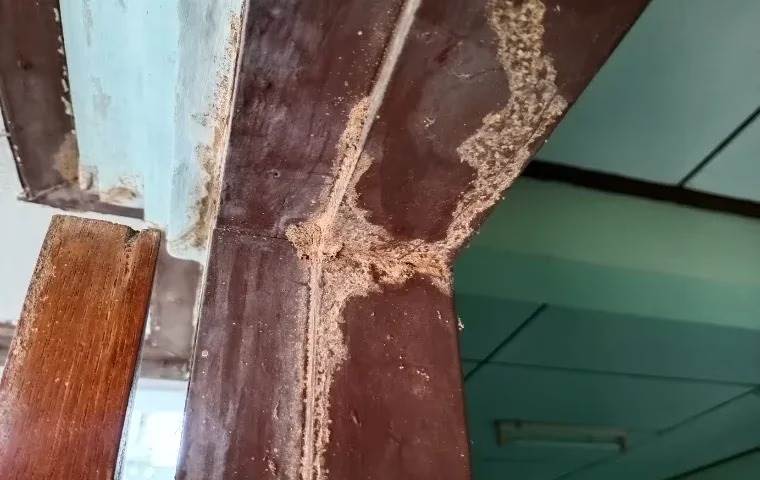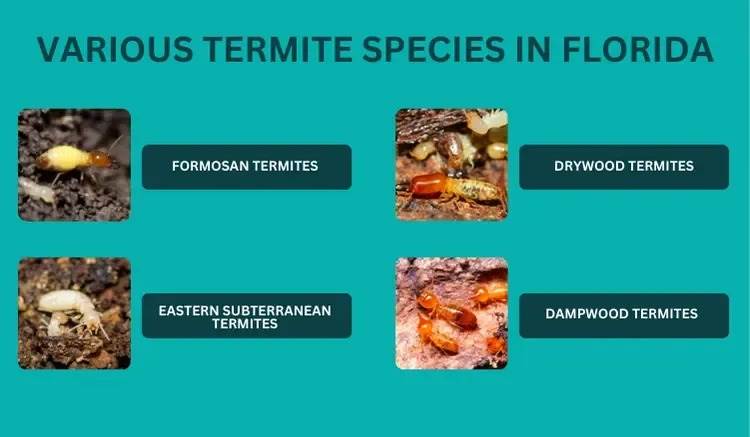Can You Live in a House That Has Termites?

Living with termites in the house is not an unheard-of scenario, especially in areas where these pests are common. It’s a creepy thought to imagine sharing your home with termites, and for good reason.
Termites often work silently and can go undetected for long periods, which allows for extensive deterioration before homeowners become aware of the issue.
If you can identify the signs of termite activity and take the right steps to mitigate their impact, you can protect your real estate and achieve peace of mind.
Key Takeaways
- Termites can severely compromise your home's structural integrity and safety.
- Identifying termite species is crucial for effective treatment.
- DIY solutions do not usually help severe infestations.
- Preventive measures, including moisture control and regular inspections, are essential to deter termite reinfestation and protect your home.
How Can Termites Make Your Home Unsafe?
Unlike cockroaches, termites are notorious for their ability to cause extensive structural damage to homes, often undetected for long periods.
The rate at which they inflict destruction can vary, typically within 3 to 15 years, depending on factors such as termite colony size and the age of the structure.
Structural Integrity Risks
Wood is a favorite food for termites, and a large infestation can compromise the strength of wooden structures.
The extent of wood consumption by termites can lead to weakened support beams and joists, which are critical to your home's stability.
Other signs of a termite infestation you should know include the following.
Sign of Damage | Details |
Hollowed or Blistering Wood | Infested wood may appear to be blistered or sound hollow when tapped. This is often due to termites tunneling close to the surface. |
Visible Mud Tubes | Termites build mud tunnels out of soil to travel to their food source. These pencil-sized tubes are often found near the home's foundation. |
Swarmers or Discarded Wings | The presence of flying termites or their discarded wings near window sills and doors is a sign of an active termite infestation. |
Cracked Paint or Plaster | Termites produce moisture when eating and tunneling through wood, which can lead to bubbling or peeling paint and plaster. |
Frass or Termite Droppings | Noticeable piles of pellets resembling sawdust or coffee grounds indicate termite waste and a new colony nearby. |
Moisture Problems
Termites are drawn to moisture, and their presence can exacerbate pre-existing moisture issues within your home.
In turn, higher moisture levels can lead to further wood damage, creating a conducive environment for more termites.
The risk of injury or significant harm escalates when termites are left unchecked, potentially making your residence unsafe.
What Happens If You Ignore a Termite Infestation?
When termites infest your home, they can cause extensive structural damage that's not always immediately visible.
If left unchecked, the integrity of the house may be compromised, leading to severe consequences.
Here's a breakdown of the issues:
- Structural Damage: Wooden drywall, support beams, and joists can be quietly hollowed out, leading to potential collapse.
- Health Risks: Damaged wood structures become more susceptible to molds due to leaks, affecting air quality and potentially causing respiratory problems.
- Electrical Hazards: Termites can chew through insulation, creating fire hazards from exposed wires.
Why Should You Address Termite Damage Early?
A house with termites risks your safety. It's vital to address termite damage early to avoid the escalation of these risks.
- Prevent Catastrophic Failures: Avoid the peril of falling through termite-weakened floors or stairs.
- Maintain Air Quality: Reduce the risk of mold growth that can impact health.
- Avoid Fire Hazards: Minimize the risk of fire from damaged electrical systems.
What Are the Health Implications of Termites?
Termites also pose potential health implications, particularly through indirect effects related to air quality and allergens.
Direct Health Effects
Termites do not typically pose a direct health threat to humans since termite bites are uncommon and generally not harmful.
Unlike other pests, they do not transmit diseases through biting. If it does occur:
- It is typically not serious.
- No treatment is usually required.
Indirect Health Effects
The primary health risks from termites arise indirectly. They can exacerbate allergies and asthma due to the fine dust and wood particles generated from their activity.
This airborne debris can lead to allergic reactions and respiratory issues when inhaled.
- Allergic Reactions: Symptoms may include sneezing, runny nose, and eye irritation.
- Asthma: Individuals with asthma might experience more frequent and severe attacks in termite-infested environments.
Sick Building Syndrome
Termites can contribute to Sick Building Syndrome (SBS), a condition resulting from poor indoor air quality. As they damage wooden structures, they can create moist conditions that foster mold growth, leading to respiratory problems like coughing and sneezing.
Symptoms of SBS
- Headaches
- Dizziness
- Fatigue
- Difficulty concentrating
How to Get Rid of Termites in Your House
Termites pose a significant threat to homes. When addressing a termite infestation, it's crucial to determine the type of termite, as it affects the termite treatment approach.
Various termite species in Florida include:

Species of Termites | Description |
Are aggressive and notorious for their rapid spread. | |
Need soil contact and create mud tubes for moisture. | |
Live directly in wood and can be harder to detect without help from termite exterminators. | |
Thrive in high moisture environments, often infesting decaying wood in contact with the ground. |
DIY Termiticide
For those inclined to tackle the issue themselves, boric acid is a common termiticide that interrupts termites' nervous systems. It’s applied in powder form or as a solution to affected areas.
- How to Apply: Sprinkle the powder around the perimeter of your home or dissolve it in water to spray on affected areas.
- Examples: Boric acid powder and Bora-Care solution.
Baits and Traps
DIY termite baits lure termites with cellulose-based food combined with a slow-acting insecticide.
The termites carry the poison back to their colony, addressing the infestation at its source.
- Placement Tips: Place bait stations around the perimeter of your home, focusing on areas where termite activity is suspected.
- Examples: Spectracide Terminate, Advance Termite Bait System.
Natural Predators
Introducing natural predators into your environment can help control the termite population without chemicals.
- Beneficial Nematodes: Microscopic worms that penetrate termites, releasing bacteria that fatally poison them.
- Examples: Nematode sprays are available at garden centers or online.
Essential Oils
Certain essential oils have been found to repel and even kill termites, offering a more natural approach to termite control.
- Neem Oil: Acts as a growth regulator, preventing termites from molting and leading to their death.
- Orange Oil: Contains D-limonene, which is lethal to termites on contact.
Soil Treatment
Creating a chemical barrier in the soil around your home can prevent termites from accessing the structure.
- Termiticides: Non-repellent termiticides are effective for creating a barrier termites cannot detect, leading them through treated areas.
- Examples: Fipronil-based products and Imidacloprid treatments.
How to Prevent Termite Reinfestation?
Employing effective preventive strategies discourages these destructive pests from re-infesting your home. Here’s how you can do it.
Remove Excess Moisture
- Fix Leaks Promptly: Repair leaking faucets, water pipes, and AC units to reduce moisture.
- Improve Drainage: Ensure gutters and downspouts are clean and direct water away from your home's foundation.
- Use Dehumidifiers: In damp areas of your home, like basements and crawl spaces, to keep humidity levels in check.
Eliminate Wood-to-Ground Contacts
- Store Firewood Away from Home: Keep firewood, lumber, and paper away from the home’s foundation and elevate them off the ground.
- Regularly Inspect Wooden Structures: Decks, patios, and fences should be checked and treated for termite prevention.
Conduct Routine Inspections
- Annual Professional Check-ups: Have professional exterminators inspect your home annually for signs of termite activity.
- DIY Termite Inspections: Regularly examine your home for mud tubes, uneven or bubbling paint, and wood that sounds hollow when tapped.
Utilize Termite Barriers
- Physical Barriers: Install barriers, such as steel mesh and sand, around your home’s foundation during construction.
When to Seek a Professional Pest Control
If you’re facing termite troubles, it's crucial to recognize when professional intervention is necessary.
Professional pest control services bring more than just their expertise and specialized tools like tenting for fumigation. They also provide customized solutions that are tailored specifically to your pest management needs.
This ensures a thorough and efficient resolution to your termite problem, safeguarding your property from further significant damage.
